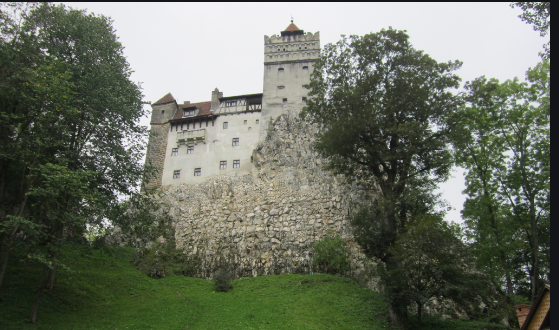[TIHCE] THE LEGEND OF DRACULA
 •
by
•
by Stephan Condurachis
Hello ... although I should write you something HORROR, however I decided to tell you the true story of a character known to everyone: DRACULA
Over time, Romanian folklore has inspired a lot of stories and fairy tales with fabulous characters and imaginary worlds, loaded with meanings and stories. The imagination of the people and the events that happened both on the villages' paths, as well as at the heart of the country, gave birth to stories that combine the real and the fantastic and in which the good always comes out victorious. Sturdy, sons of emperors, beautiful girls, simple people of the people, Ilene Cosânzene, witches, seven-headed brooms, all these magical characters lead a continuous, adventurous fight, which the reader savors with awe.


Some stories contain more historical truth than others and have been so often told that they have become true legends of the Romanian people. They evoke real facts, which over time have been distorted or confused with other events, so that the listener must unravel mysteries and unravel the tangled facts of events. This is the case with the legend of Dracula, who gained a mystical aura due to the numerous writings and films that depict him as a ruthless, bloodthirsty vampire. In fact, Count Vlad's story is completely different than Bram Stocker describes in the novel "Dracula". Thus, here is the story of the life of Ţepeş, one of the greatest rulers of the Vallachia.
Prince Tepes, the merciless justice
Vlad Tepes was born into a noble family, his ancestors being rulers of Wallachia, a region located south of the Carpathians. His father was very fond of the King of Hungary, Sigismund of Luxembourg, who called him Knight of the Order of the Dragon, a group of European nobles of the highest rank who wanted to protect Christianity from the Ottoman threat. The symbol of this order was a gold medallion representing a braided dragon. In Latin, "draco" means "dragon", but in Romanian it is very close to "devil". Because the order was inherited from father to son, Vlad Tepes was chosen by the name of Vlad Dracul or Dracula, which means both "dragon bearer" and "son of the devil".
From an early age, Vlad was captured in the battle for power, manifested in this region between the Kingdom of Hungary and the Ottoman Empire. At just 11 years old, he and his brother Radu were taken to the Sultan's court as security for the period when their father would remain on the throne. As a hostage, Vlad gathered a hatred against the Turks, while Radu was a close relative of the Sultan.
In 1448, after the death of his father, Vlad becomes ruler of Wallachia, title for which he must carry many battles with his rivals. It took eight years to get the throne from Targoviste. Here he is now on the throne, with a burning desire to get rid of Christianity under the Turkish yoke. Before embarking on a fierce attack on the Sultan, Vlad wanted his country to be well-managed, wealthy, with ready-made armies and ready to help allies in case of distress. For the first time, the great boyars he suspected were the ones who were against them. Until we find out how justice was instituted in Wallachia, I have to tell you what is fired, this terrible punishment that gave the voivode the name of Tepeş and which made him famous both in the country and throughout Europe.
Pulling into the sky was the most horrific torture used to snatch confessions or end a man's life, similar to burning at the time. The sheath was a large tar, taller than the stature of a man, with a very sharp point; it pierced the man through the belly or back, coming to the surface through the neck or mouth. Then he was stuck in the ground, so that the defendant hung his arms and head. The purpose of the punishment was to cause unspeakable physical suffering, and his death did not occur immediately. The convict died of either starvation or thirst, or because of the crows attack. The image was so frightening to the viewers that no one wanted to break the laws in Ţepeş's country.
Gradually, Vlad escaped the enemy boyars, beggars and thieves, strengthened the cities and the army and brought new weapons. Another measure of the ruler was directed against the Saxon merchants doing retail in the country, depriving the local Romanian merchants for much of the profit. It is understood that the Saxons who disobeyed the command were drawn to the stake. During the six years of his reign, Tepes punished Brasov and Sibiu for supporting another claimant to the throne. In 1462, Vlad was betrayed by his brother and imprisoned for 12 years by the King of Hungary, Matei Corvin. Tepeş recaptures the Wallachia chair for the last time, but dies shortly after a Turkish invasion (1476). Some legends say he was shot down by enemies in battle, others claim he was assassinated by the Wallachian boyars or was confused by his efforts with a Turkish commander. The ruler's head was sent to Constantinople to dispel any doubts about his death, and the body, buried at Snagov Monastery, was never found.


The feared Ţepeş was an extremely complex character, known especially for his qualities as leader of the country. Good strategist and very brave, he did not hesitate to face the Turks even when his army was outnumbered. Rough, ruthless and uncompromising, Vlad was respected by the people and supported in the fight of soldiers. His virtues were overshadowed by excessive cruelty, behind which stood the spirit of justice and honesty. Ţepeş hated so much the lie, the cowardice, the robberies and the treachery that nobody could escape the punishment; neither the boyars, the priests or the monks could redeem themselves. The voivode had so much horror in them that the fountains lay golden cups that no one had ever dared to steal.
A lesser-known story about Vlad Tepes is that he talks about his human nature, romance, and his love affair with Katharina Siegel. The daughter of a weaver from Corona (Brasov today), Katharina stayed with the ruler for 20 years, giving her five children. When he met Vlad, the 17-year-old struggled to pull a sled with snacks, and the brave one, passing by, jumped to his aid. Tepeş fell in love with her, oblivious to the other love affair, and tried everything to seduce her.
In 1459, when the ruler punished the Saxons who traded in the city of Brasov, the merchants' wives seized her face, tied her to the pillar of infamy and cut her mops. In order to escape the young woman from the anger of the Saxons, Tepes had to release the merchants. Vlad very much wanted to marry Katharina, so he asked the Pontiff to cancel the marriage with his first wife, Anastasia. The two did not manage to formalize their relationship, because the ruler was imprisoned by King Matthew Corvin. Katharina remained loyal to Vlad during this time, and after his death retired to the monastery. Although presented above all as a bloody tyrant, here Ţepeş had feelings of the most humane, being irrevocably in love with the beautiful Katharina.
The fame of Vlad Ţepes has aroused the imagination of many writers, giving birth to scary stories even during the ruler's life. Because he had attracted enemies among the boyars and the Saxons, Tepeş became the main character of exaggerated legends, who portrayed him as a diabolical character. At that time the pattern also appeared, so that the manuscripts about the voivode quickly made their way around the country and Europe.
The German narratives and the Ottoman chronicles highlight especially the negative traits, presenting a cruel, ruthless, cunning, even irrational ruler. An ex-builder of the Ottoman army told how, in the campaign of 1462, Tepes cut off the noses of all the Turkish captives and sent them to King Matthew Corvin, thus showing his success. Another tells how the ruler ordered the fortress to be surrounded by two rows of fences, and the place between them to be filled with Moldovans, Hungarians and Wallachians drawn into the stern. And not only that; hanging from the tree branches hung people and Voda ordered that those who would take them down would be tied in their place.
The stories of the Saxons were inspired by the devastating incursions of the ruler in Transylvania, where churches, men and women and children alike were burnt down. The events of the time were the subject of widespread legends. For example, it is said that several saints sent by the sultan came to Voda; when they showed up, they took off their turban, but not the tits they were wearing underneath. Then the prince put the buttocks on their heads with three nails, so that they would never remove them.
Another story tells that Ţepeş met with a peasant who wore a broken and dirty shirt. The brave asked him if he has a wife and if he sowed in that year, and the man replied that he has a woman, and quite in. Then Voda went to the peasant's house and, wanting to punish the woman's laziness, cut off her hands and threw her in the stern. It was also said that during the second reign, Ţepeş wanted to clean the country of beggars, thieves, sick and old people, so he called them all in a house, where he had spread tables loaded with kindness. After he held them, he set the house on fire, not caring for the cries of those inside.
The ambassadors who were not dressed in a chosen way and who did not know how to answer his questions were also punished. None of these legends depict the vampire Dracula as Bram Stocker did in the novel of the same name. Finding out from a Hungarian teacher of a Romanian ruler who was called Dracula, the author created a mysterious and sinister character. He lived in a castle in Transylvania, and at nightfall he turned into an owl and sucked the blood of people. The victims were also transformed into vampires and fulfilled the wishes of the count. The modern story distorts the nature of the medieval character, exploiting the public's appetite for horror stories. Tepeş remains in the history of the Romanian people a true justice, loving the country and very brave.

Tourists who come to Romania attracted by the myth of Dracula are heading especially to Bran Castle, where they are expected to find a scary, dark, haunted place for ghosts. Indeed, the palace evokes the fascinating medieval atmosphere, Vlad Ţepeş spending here a period during the years of imprisonment which was subjected by King Matei Corvin. At Bran, the first to erect a fortification were the Teutonic knights, then the Brasovians built on the same place a stone citadel. The resemblance to the residence of the vampire count in Stocker's novel made Bran Castle the main objective of tourists eager to rebuild Dracula's road.
Such an itinerary must necessarily tick the city of Sighisoara, the place where the father of Vald Tepes lived and where the ruler was supposed to be born. One of the most beautiful medieval cities in Europe, Sighisoara impresses with the architectural richness of old houses and towers. On the narrow streets you will discover new stories about the dreaded voivode who frightened the Saxons of Transylvania.
Targoviste was the capital of Wallachia during the reign of Vlad Tepes. It is said that at the Royal Court he used to organize those great celebrations after which he was firing on enemy boyars. Here you can also visit the Tower of Chindiei, where there are exhibited weapons that belonged to the ruler himself.
On Transfagarasan, along a route full of adrenaline and spectacular scenery, you will see Poienari Fortress, where Tepes found a last place of refuge before leaving for Transylvania. Legends tell that in the fifteenth century, when the fortification was restored, Voda wanted to avenge the boyars from Targoviste, guilty of the death of his brother or Mircea. Some killed in his characteristic style, while others condemned him to work on erecting the walls; many of them gave their lives on the slopes of the mountain. Do not let yourself be discouraged by the 1480 steps because the panorama that opens to the Fagaras Mountains and the Arges Valley is worth the effort.
Bucharest is another place where Tepes left his mark. In the center of the city can be visited the ruins of the Prince Court built in the fifteenth century, known today as the Old Court Palace. According to legends, prisoners were kept in the underground cellars. Near the city is the Snagov Monastery, the place where the ruler was buried. Although his body remains were never found, the place of worship bears the memory of the great Ţepeş.
Hero in charge of the fight for justice, masterful determined to free the people from the Turkish yoke, one of the most cruel rulers known to the Roman Countries, a ruthless and bloody despot, the vampire count shrouded in mystery, so is known Tepes, said Dracula, in the country and abroad. Justice that the Romanians often invoke and mysterious character that intrigues the aliens, Ţepeş remains one of the most controversial figures in history. The official documents and the stories hidden in the people have interwoven so much over time that no one can say exactly how many of the legends woven around him are true and how many are myths.


Comments
https://www.erepublik.com/ro/article/-tihce-the-legend-of-dracula--2706326
vvv
The only legend of Dracula you need to know is:
https://www.erepublik.com/en/citizen/profile/4029238
😛
🧛♂️🧛♂️🧛♂️🧛♂️🧛♂️
o7
R.
Woa such a long story. Writing this halfway, will continue reading hehe
Nice work
this is a part of my country history
So many stories really bring mr Dracula alive
o7
a good story
Good one
What do you want, mortal?
Thank you for participating and for sharing a bit of history, especially for a character that widely known through the pop media.
Very cool o7
spiritul halloweenului?
da da
Glad you mentioned Bram Stoker. The "Anglo-Saxon" reference is way off though. Samhain is an old pagan practice, exclusively Celtic. The Anglo-Saxons came much latter.
Awesome presentation of the history of Vlad the Impaler as the Ottomans knew him 😛
😃